La Femme S' Affiche/Women In Posters
The portrayal of women in posters, in fact in all advertising media, has remained a central subject for the last 125 years. As the technological tools available to marketers has advanced, the dominant use of the female persona to sell products and services has remained steady.
 |
Women have been depicted in posters to sell everything from Soup to Soap, Coffee to Liquor, Bikes to Cars, Sports, With the 1920's women and fashion entered the modern era. Gone were the restictions of the past decades. Clothing became more comfortable, womens arms were bare, skirts and hair were worn shorter and hats were often "the accessory". |
 |
|
| "Palace Hotel St. Moritz" Emil Cardinaux 1920 |
"Alice Lloyd" Alfonso Ianelli c.1915 |
||
 |
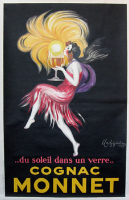 |
 |
 |
| "Araby Savon Toilette" Anonymous 1920's |
"Cognac Monnet" Cappiello 1922 |
"Cafes Gilbert" Jal 1923 |
"Vichy Ses Sources" Roger Broders 1928 |
The images and ideas in advertisments are certainly not immune to the political and cultural vibrations of their time, and the media is often a facinating lens into the greater picture. The poster is an authentic mirror of the time, reflecting the spirit and values of the period.
 |
>During the 1930's, the deco design style was developed and its influence was broadly used in the graphics of posters. However, the fashionable woman returned to a more genteel,ladylike appearance, a softer more cuvacious profile with softer hair. |
> |
| "Lux Toilet Soap Anonymous 1930's |
"La Granero" Paul Colin 1935 |
 |
 |
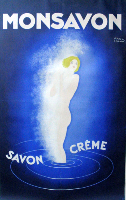 |
| "Corsets Le Furet" Roger Perot 1933 |
"California Travel by Train" Anonymous 1930 |
"Monsavon" Paul Colin c. 1930 |
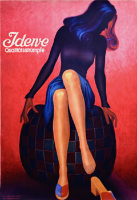 "Idene" Victor Reutz 1943 |
In the1940's our lives were puctuated by WWII and recovering from "The Great Depression". Despite the hardships of this time period, fashion still "ruled". The technological advances brought by the war and the necessity of women's place in the work force created a more utilitarian, yet chic look.
Towards the end of the decade a new era was ushered in. Begining in the late 1940's and early 1950's we see the "Golden Age of Graphic Design" and the poster at it's best. Fashion moved from utilitarian to pure glamour. |
 "Telephonieren" Hans Falk 1951 |
 |
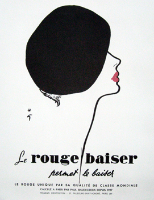 |
 |
| "Frigor Blue Glove" Victor Reutz 1940's |
"Le Rouge Basier Baret" Rene Gruau 1949 |
"Seiden Grieder" Hans Falk 1950 |
Messages given to the general public through posters enabled the economy to prosper and encouraged cultural communication; posters were part of an active social and economic development. The iconographic message, the posters language, will catch the eye immediately, it's message understood in an instant. The use of the female figure, along with color, innovative design elements and well composed typography achieves this.
 "Chrysler New Yorker" Anonymous 1952 |
The early 1960's seemed to reflect the elegance of Audrey Hepburn and Jackie Kennedy. The mid 60's and into the 70's we entered a period that broke with many traditions. It was the young, common people that dictated fashion and its reflection of the changing social, political and cultural changes that were taking place in the world. Hemlines went up, men's hair got long, and a new sexual liberty appeared. Posters moved away from a purely graphic presentation to a more photographic/combination of media. |
 "Las Vegas Fly TWA" David Klein 1955 |
 |
 |
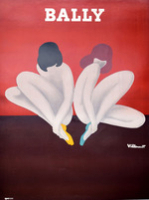 |
| "Blizzand" Rene Gruau 1965> |
"Los Angeles Western Air" Anonymous 1970 |
"Bally Lotus" Bernard Villemot 1973 |
The subject of the depiction of women in advertiments is one that is often debated and often hotly debated. It is entirely possible that advertisers are purely interested in the images and themes that sell. Especially given they are in business to make money and are responding to what research has shown their audience responds to.
 |
"There is no such thing as an ugly woman." Vincent Van Gough
"Women are always Beautiful!" Ville Valo "Women who seek to be equal with men lack ambition." "Sure God created man before woman. But then you always make a rough draft before the final masterpiece." Unknown |
 |
| "Rifle Jeans" Werbung 1982 |
"Di..Di..Di..Dim Up" Anonymous 1980 |
